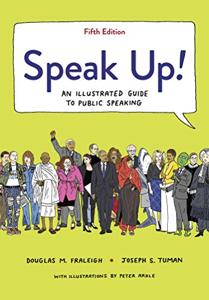
Want to learn the ideas in Speak Up better than ever? Read the world’s #1 book summary of Speak Up by Douglas M. Fraleigh, Joseph S. Tuman here.
Read a brief 1-Page Summary or watch video summaries curated by our expert team. Note: this book guide is not affiliated with or endorsed by the publisher or author, and we always encourage you to purchase and read the full book.
Video Summaries of Speak Up
We’ve scoured the Internet for the very best videos on Speak Up, from high-quality videos summaries to interviews or commentary by Douglas M. Fraleigh, Joseph S. Tuman.
1-Page Summary of Speak Up
Preparation: Know What You Are Going to Say
Anyone can be a great public speaker. There are specific techniques and skills that make up the craft of being a good speaker. If you follow these guidelines, you’ll be able to deliver speeches like an experienced professional. The first rule of good speaking is preparation. You should always prepare your speech ahead of time, no matter what the situation is or how long it will take (although if it’s longer than 15 minutes, it might help to have notes). To do this well, you need to know why you’re giving the speech in the first place and what response(s) from your audience would indicate success; write down everything based on those goals so that they’re clear in your mind and easy for others to understand as well. Next comes delivery: choose appropriate stories and anecdotes (only if relevant), keep things interesting by varying your tone/pace/volume appropriately during each part of your presentation, use understandable language with correct grammar and spelling when possible, etc., but don’t overdo any one thing since excessive emphasis usually detracts from effectiveness instead of adding value
It is important to sketch out the ideas you want to say before writing them down. Then, write a draft using your notes and edit it for repetition, bad grammar or other problems. Record yourself reading the draft several times over until you are comfortable with the language and tone of your speech.
Before you speak, write the speech several times to check for:
Repetition of words or information that is not needed.
Correct grammar and spelling.
Bad wording (for example, “There are many things in life” instead of “Life has many things”).
When writing your presentation, make sure that you use only verifiable information. Break the information down into simple statements or itemized details. Start with the simplest issues and work up toward the most complicated ones; then, summarize your message. Don’t make too many points – just the ones you want your audience to remember. Edit shamelessly to get rid of excess stories, metaphors and other unnecessary stuff from your speech. Follow long sentences with short ones in order to improve your cadence and breathing while speaking in public. Be cautious about adding elaborate expressions if you are a novice speaker as they can be distracting for an audience; offer a closing summary to leave a strong impression on them when finished talking.
Preparation: Know How You Are Going to Say It
A successful speaker is believable and persuasive. To establish a connection with your audience, you must make eye contact. You can’t hold an audience’s attention if you’re looking at your notes. Familiarize yourself with the material so much that you seem to be writing it from memory, because then people will believe that what you’re saying is coming from the heart instead of written on paper or memorized word for word.
There are three ways to deliver a speech: from a written text, with notes or without any notes. Each method should be prepared differently: 1. Speaking from a written text – Unless you’re extremely familiar with the subject, it’s best to read off of your script so that you don’t stumble over complicated words or phrases. Use underlining, circles and pauses to indicate emphasis. Make sure the cadence of the language isn’t dull or monotonous by practicing in front of a mirror until it feels comfortable enough for you to use in front of an audience. Photograph your script; go over it multiple times until each paragraph is engrained into your mind before moving on to the next one. When every sentence has been memorized completely, recite only the first sentence as many times as possible before going onto the second one and then continue this way through out all paragraphs on your page(s). If you do not have time for this step because there is not much time left before giving your speech, at least try saying aloud (or mentally) just one paragraph repeatedly until that can also be done quickly and easily without having to look down at what you’re saying while looking up at an audience member/s occasionally during delivery 2.






